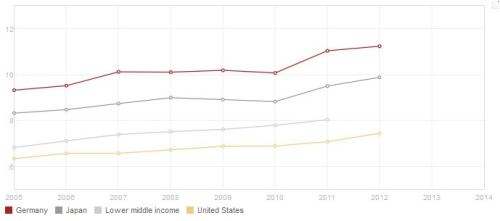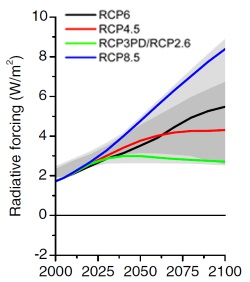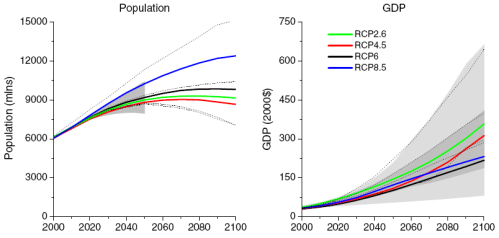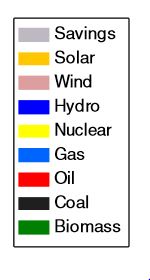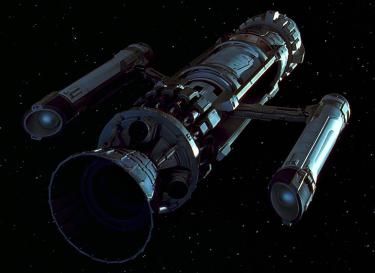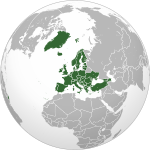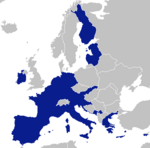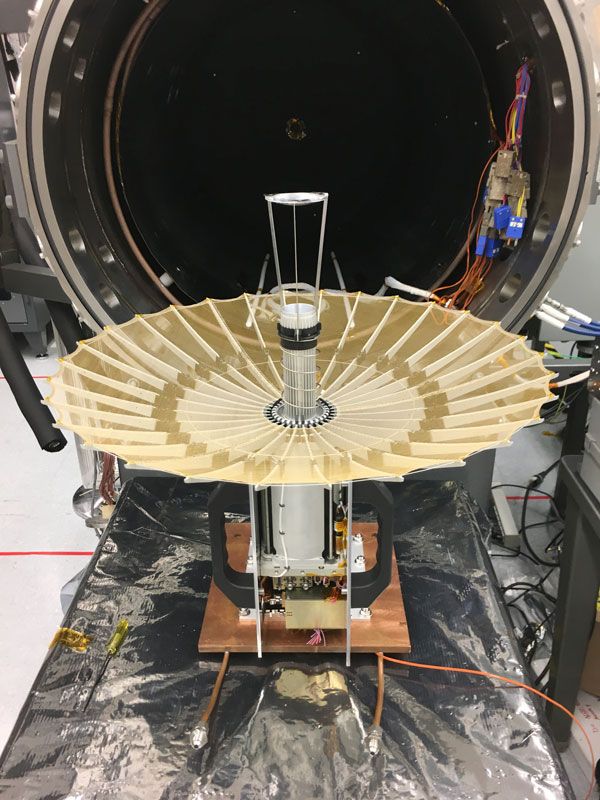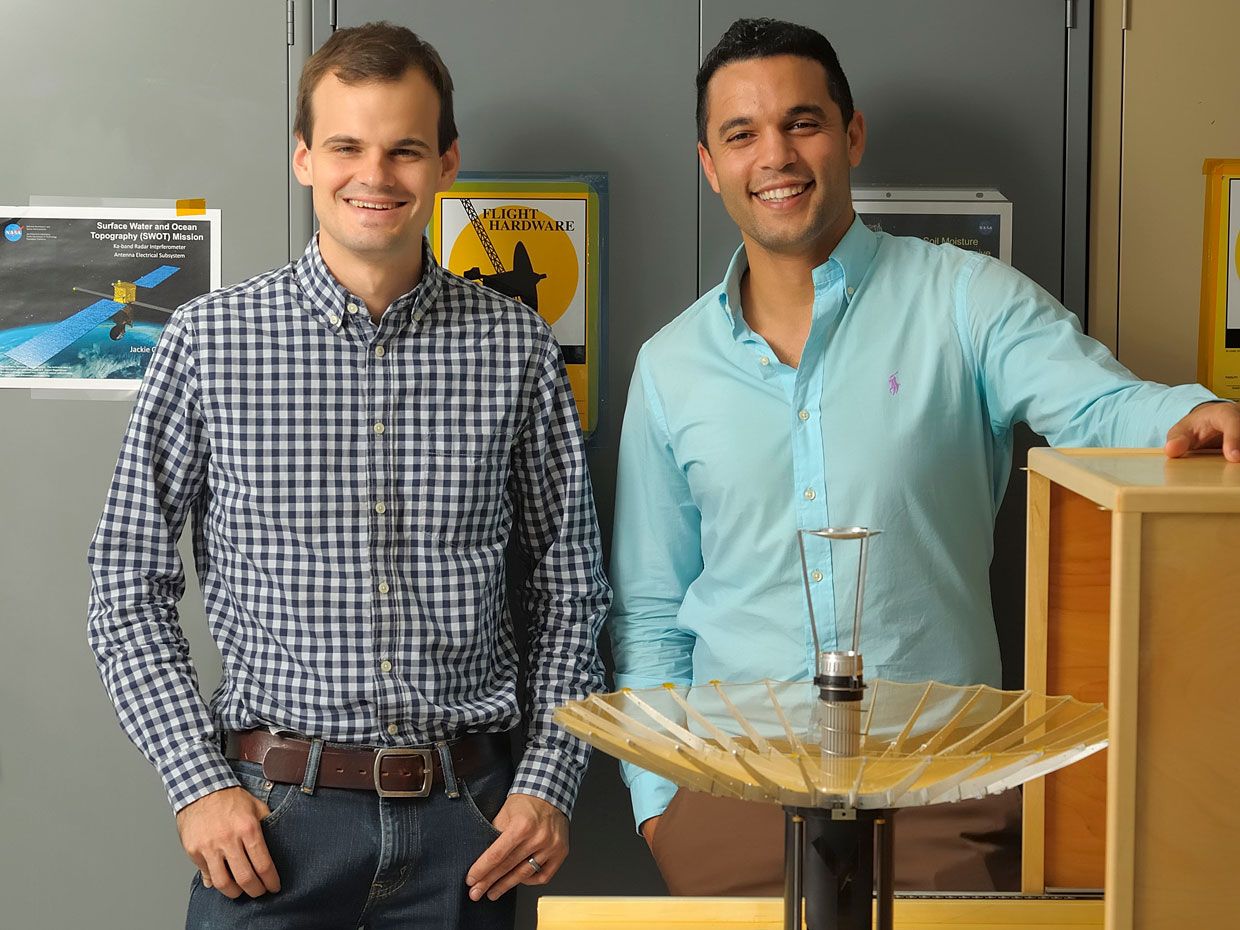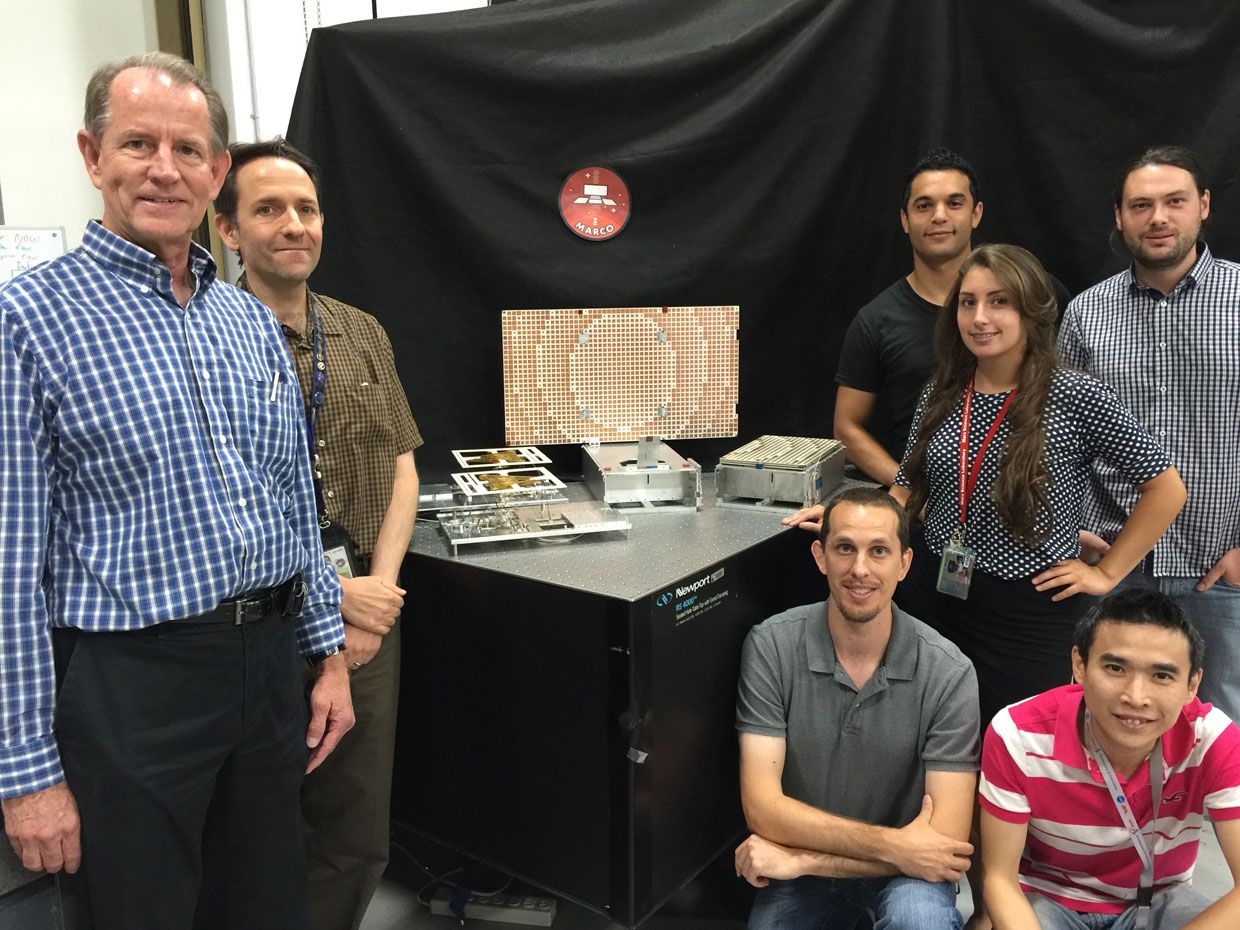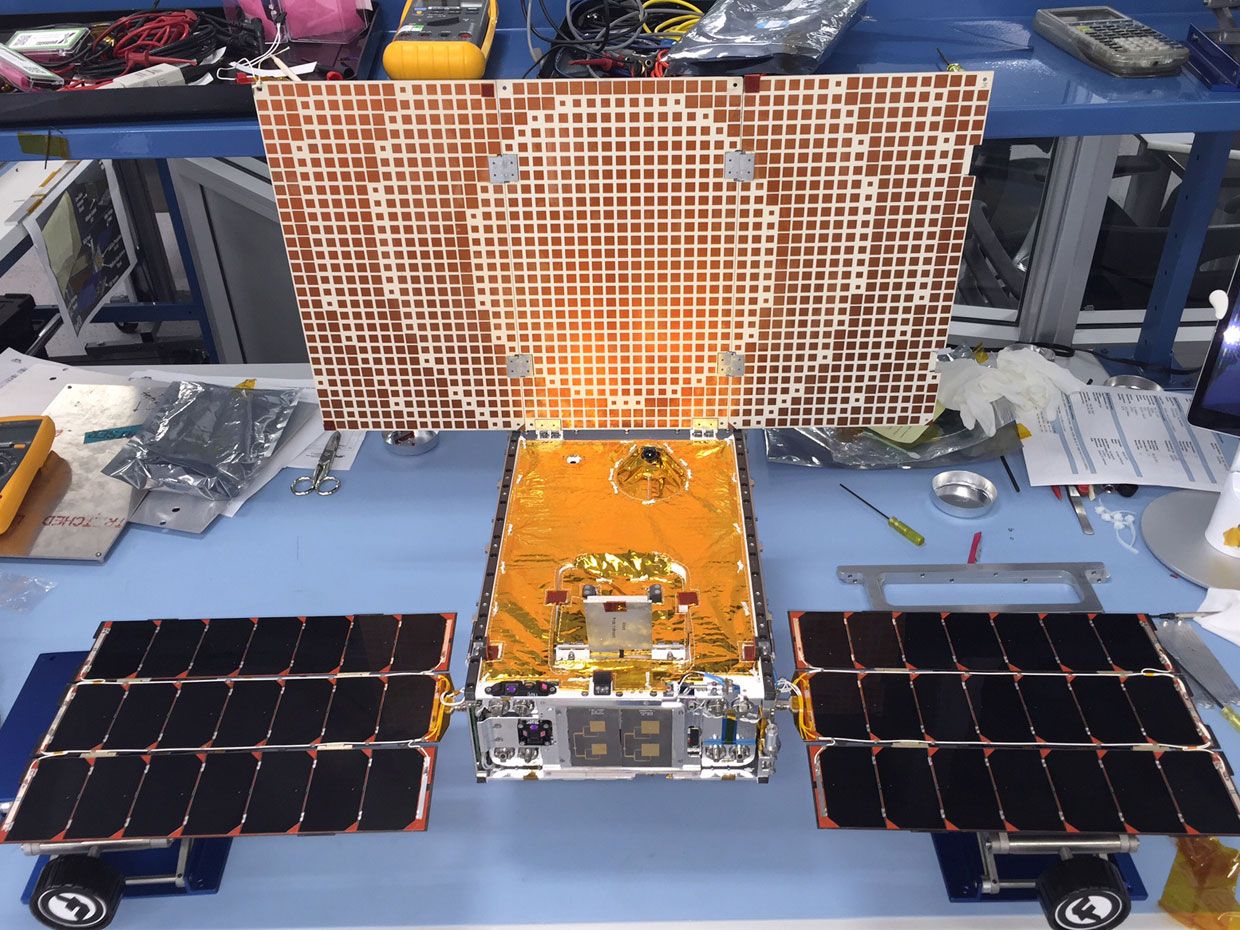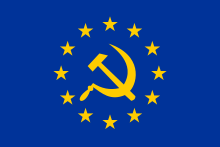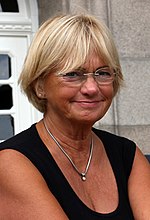From Wikipedia, the free encyclopedia
Euroscepticism (also known as
EU-scepticism) means criticism of the
European Union (EU) and
European integration.
It ranges from those who oppose some EU institutions and policies and
seek reform ("soft Euroscepticism"), to those who oppose EU membership
outright and see the EU as unreformable ("hard Euroscepticism" or
"anti-European Unionism"/"anti-EUism"). The opposite of Euroscepticism is known as
pro-Europeanism (or European Unionism).
The main sources of Euroscepticism have been beliefs that integration undermines national
sovereignty and the
nation state; that the EU is
elitist and
lacks democratic legitimacy and
transparency; that it is too
bureaucratic and wasteful; that it encourages high levels of migration; or perceptions that it is a
neoliberal organisation serving the
business elite at the expense of the working class and responsible for
austerity.
Euroscepticism is found in groups across the
political spectrum, both
left-wing and
right-wing, and is often found in
populist parties. Although they criticise the EU for many of the same reasons, Eurosceptic
left-wing populists focus more on economic issues (such as the
European debt crisis) while Eurosceptic
right-wing populists focus more on nationalism and immigration (such as the
European migrant crisis). The recent rise in
radical right-wing parties is strongly linked to a rise in Euroscepticism.
Eurobarometer surveys of EU citizens show that trust in the EU and its institutions has declined strongly since a peak in 2007. Since then it has been consistently below 50%. A 2009 survey showed that support for EU membership was lowest in the
United Kingdom (UK),
Latvia and
Hungary. By 2016, the countries viewing the EU most unfavourably were the UK,
Greece,
France and
Spain. A
referendum on continued EU membership was held in the UK in 2016, which resulted in a 51.9% vote in favour of
leaving the EU.
Since 2015, trust in the EU has risen slightly in most EU countries as a
consequence of falling unemployment rates and accelerating economic
growth.
Euroscepticism should not be confused with
anti-Europeanism, which is a dislike of
European culture and
European ethnic groups by non-Europeans.
Global outlook
While having some overlaps, Euroscepticism and
anti-Europeanism are different. Anti-Europeanism has always had a strong influence in American culture and
American exceptionalism, which sometimes sees Europe on the decline or as a rising rival power, or both. Some aspects of
Euroscepticism in the United Kingdom have been mirrored by U.S. authors.
Terminology
There can be considered to be several different types of Eurosceptic
thought, which differ in the extent to which adherents reject
integration between member states of the
European Union
(EU) and in their reasons for doing so. Aleks Szczerbiak and Paul
Taggart described two of these as hard and soft Euroscepticism.
Hard Euroscepticism
According to Taggart and Szczerbiak, hard Euroscepticism (also called anti-EU-ism)
is "a principled opposition to the EU and European integration and
therefore can be seen in parties who think that their countries should
withdraw from membership, or whose policies towards the EU are
tantamount to being opposed to the whole project of European integration
as it is currently conceived."
The
Europe of Freedom and Direct Democracy group in the
European Parliament, typified by such parties as the
United Kingdom Independence Party
(UKIP), displays hard Euroscepticism. In western European EU member
countries, hard Euroscepticism is currently a characteristic of many
anti-establishment parties.
Some hard Eurosceptics prefer to call themselves 'Eurorealists'
rather than 'sceptics', and regard their position as pragmatic rather
than "in principle". Additionally,
Tony Benn, a left-wing
Labour Party MP who fought against
European integration in 1975 by opposing membership of the
European Communities in
that year's referendum on the issue, emphasised his opposition to
xenophobia
and his support of democracy, saying: "My view about the European Union
has always been not that I am hostile to foreigners, but that I am in
favour of democracy [...] I think they're building an empire there, they
want us to be a part of their empire and I don't want that."
The Czech president
Václav Klaus
rejected the term "Euroscepticism" for its purported negative
undertones, saying (at a meeting in April 2012) that the expressions for
a Eurosceptic and their opponent should be "a Euro-realist" and someone
who is "Euro-naïve", respectively.
François Asselineau of the French
Popular Republican Union
has criticised the use of the term 'sceptic' to describe hard
Eurosceptics, and would rather advocate the use of the term "Euro
opponent".
However, he believes the use of the term 'sceptic' for soft
Eurosceptics to be correct, since other Eurosceptic parties in France
are "merely criticising" the EU without taking into account the fact
that the
Treaty of Rome can only be modified with a unanimous agreement of all the EU member states, something he considers impossible to achieve.
Soft Euroscepticism
Soft
Euroscepticism is support for the existence of, and membership of, a
form of European Union, but with opposition to specific EU policies; or,
in Taggart's and Szczerbiak's words, "where there is NOT a principled
objection to European integration or EU membership but where concerns on
one (or a number) of policy areas lead to the expression of qualified
opposition to the EU, or where there is a sense that 'national interest'
is currently at odds with the EU's trajectory." The
European Conservatives and Reformists group, typified by centre-right parties such as Czech
Civic Democratic Party, along with the
European United Left–Nordic Green Left which is an alliance of the left-wing parties in the European Parliament, display soft Euroscepticism.
Criticism of terms 'soft' and 'hard' Euroscepticism
Some have claimed that there is no clear line between the presumed 'hard' and 'soft' Euroscepticism. Kopecky and
Mudde
have said that if the demarcation line is the number of and which
policies a party opposes, then the question arises of how many must a
party oppose and which ones should a party oppose that makes them 'hard'
Eurosceptic instead of 'soft'.
Other terms
Some scholars consider the gradual difference in terminology between
'hard' and 'soft' Euroscepticism inadequate to accommodate the large
differences in terms of political agenda. Therefore, "hard
Euroscepticism" has also been referred to as "Europhobia" as opposed to
mere "Euroscepticism". Other alternative names for 'hard' and 'soft' Euroscepticism include,
respectively, "withdrawalist" and "reformist" Euroscepticism.
Eurobarometer surveys
From the Parlameter 2018 poll, to the question "Taking everything into account, would you say that [our country] has on balance benefited or not from being a member of EU?", the interviewed answered "Benefited" with the following percentages:
91-100%
81-90%
71-80%
61-70%
51-60%
41-50%
From the Parlameter 2018 poll, to the question "If a referendum was held tomorrow regarding [our country]'s membership of the EU, how would you vote?", the interviewed answered "I would vote to remain in the EU" with the following percentages:
81-90%
71-80%
61-70%
51-60%
41-50%
A survey in November 2015, conducted by
TNS Opinion and Social on behalf of the
European Commission,
showed that, across the EU as a whole, those with a positive image of
the EU are down from a high of 52% in 2007 to 37% in autumn 2015; this
compares with 23% with a negative image of the EU, and 38% with a
neutral image.
About 43% of Europeans thought things were "going in the wrong
direction” in the EU, compared with 23% who thought things were going
"in the right direction" (11% "don't know").
About 32% of EU citizens tend to trust the EU as an institution, and about 55% do not tend to trust it (13% "don't know"). Distrust of the EU was highest in
Greece (81%),
Cyprus (72%),
Austria (65%),
France (65%) and
Germany, the
United Kingdom (UK) and the
Czech Republic
(all 63%). Overall, more respondents distrusted their own government
(66%) more than the EU (55%). Distrust of national government was
highest in Greece (82%),
Slovenia (80%),
Portugal (79%), Cyprus (76%) and France (76%).
A Eurobarometer survey carried out four days prior to and six days after the
U.S. presidential election in November 2016 revealed that the surprise victory of
Donald Trump
caused an increase in the popularity of the European Union in Europe.
The increase was strongest among the political right and among
respondents who perceived their country as economically struggling.
A survey carried out in April 2018 for the European Parliament
by Kantar Public consulting found that support for the EU was “the
highest score ever measured since 1983”. Support for the EU was up in
26 out of 28 EU countries, the exceptions being Germany and the UK,
where support had dropped by about 2% since the previous survey. Almost
half (48%) of the 27,601 EU citizens surveyed agreed that their voice
counted in the EU, up from 37% in 2016, whereas 46% disagreed with this
statement. Two-thirds (67%) of respondents felt that their country had
benefited from EU membership and 60% said that being part of the bloc
was a good thing, as opposed to 12% who felt the opposite. At the height
of the EU's financial and economic crises in 2011, just 47% had been of
the view that EU membership was a good thing. Support for EU membership
was greatest in
Malta (93%),
Ireland (91%),
Lithuania (90%),
Poland (88%),
Luxembourg (88%),
Estonia (86%) and
Denmark (84%) and lowest in
Greece (57%),
Bulgaria (57%),
Cyprus (56%),
Austria (54%), the
UK (53%) and
Italy
(44%). When asked which issues should be a priority for the European
Parliament, survey respondents picked terrorism as the most pressing
topic of discussion, ahead of youth unemployment and immigration. Not
all countries shared the same priorities, however. Immigration topped
the list in Italy (66% of citizens surveyed considered it a priority
issue), Malta (65%) and
Hungary (62%) but fighting youth unemployment and support for economic growth were top concerns in
Spain, Greece, Portugal, Cyprus and
Croatia. Social protection of citizens was the top concern for Dutch, Swedish and Danish respondents.
History in the European Parliament
1999–2004
A study analysed voting records of the Fifth European Parliament and ranked groups, concluding:
"Towards the top of the figure are the more pro-European parties (PES,
EPP-ED, and ALDE), whereas towards the bottom of the figure are the more
anti-European parties (EUL/NGL, G/EFA, UEN and EDD)."
2004–09
In 2004, 37
Members of the European Parliament (MEPs) from the UK,
Poland,
Denmark and
Sweden founded a new European Parliament group called "
Independence and Democracy" from the old
Europe of Democracies and Diversities (EDD) group.
The main goal of the ID group was to reject the proposed
Treaty establishing a constitution for Europe.
Some delegations within the group, notably that from UKIP, also
advocated the complete withdrawal of their country from the EU, while
others only wished to limit further European integration.
2009 elections
The
elections of 2009
saw a significant fall in support in some areas for Eurosceptic
parties, with all such MEPs from Poland, Denmark and Sweden losing their
seats. However, in the UK, the Eurosceptic UKIP achieved second place
in the election, finishing ahead of the governing Labour Party, and the
British National Party (BNP) won its first ever two MEPs. Although new members joined the ID group from Greece and the
Netherlands, it was unclear whether the group would reform in the new parliament.
The ID group did reform, as the
Europe of Freedom and Democracy (EFD) and is represented by 32 MEPs from nine countries.
2014 elections
The
elections of 2014
saw a big anti-establishment vote in favour of eurosceptic parties,
which took around a quarter of the seats available. Those that won their
national elections included: UKIP in the UK (the first time since 1906
that a party other than Labour or the Conservatives had won a national
vote), the
National Front in France, the
People's Party in Denmark and
Syriza in Greece. Second places were taken by
Sinn Féin in Ireland and the
Five Star Movement in Italy.
Herman Van Rompuy, the
President of the European Council,
agreed following the election to re-evaluate the economic area's agenda
and to launch consultations on future policy areas with the 28 member
states.
Euroscepticism in the EU member states
Austria
As of 2013, six parties together held all 183
National Council seats, and all bar one of the 62
Federal Council seats and 19 European Parliament seats. The
Sozialdemokratische Partei Österreichs (SPÖ - social democrats), which holds 56/183 NC, 24/62 FC, and 5/19 EP seats, is pro-European integration, as is the
Österreichische Volkspartei (ÖVP - conservative/Christian), which holds 51/183 NC, 28/62 FC, and 6/19 EP seats, and
Die Grünen – Die Grüne Alternative (green), which holds 20/183 NC, 3/62 FC, and 2/19 EP seats.
The
Freiheitliche Partei Österreichs (FPÖ), established in 1956, is a right-wing populist party that mainly attracts support from young people and workers.
In 1989, it changed its stance over the EU to Euroscepticism. It
opposed Austria joining the EU in 1994, and opposed the introduction of
the
euro in 1998. The party would like to leave the EU if it threatens to develop into
a country, or if
Turkey
joins. The FPÖ received 20–27% of the national vote in the 1990s, and
more recently received 17.5% in 2008. It currently has 34/183 National
Council seats, 4/62 Federal Council seats, and 2/19 European Parliament
seats.
The
Bündnis Zukunft Österreich
(BZÖ), established in 2005, is a socially conservative party that has
always held Eurosceptic elements. In 2011 the party openly supported
leaving the
eurozone, and in 2012 it announced that it supported a full withdrawal from the European Union. The party has also called upon a referendum on the Lisbon Treaty.
In polls it currently receives around 10%–15%, although in one state it
did receive 45% of the vote in 2009. It currently has 13/183 National
Council seats, 0/62 Federal Council seats, and 1/19 European Parliament
seats.
Team Stronach,
established in 2012, has campaigned to reform the European Union, as
well as to replace the euro with an Austrian Euro. In 2012, it regularly
received 8–10% support in national polls.
Politicians from many different parties (including the Social
Democratic Party and the BZÖ) as well as previous independents switched
their allegiances to the new party upon creation. In two local elections in March 2013, it won 11% of the vote in
Carinthia, and 10% of the vote in
Lower Austria. It currently has 6/183 National Council seats, 1/62 Federal Council seats, and 0/19 European Parliament seats.
Ewald Stadler,
a former member of FPÖ (and later of BZÖ) was very Eurosceptic, but in
2011 became member of the European Parliament due to the Lisbon Treaty.
Before Stadler accepted the seat, this led to heavy critics by Jörg
Leichtfried (SPÖ) "Stadler wants to just rescue his political career"
because Stadler before mentioned he would never accept a seat as MEP if
this was only due to the Lisbon Treaty. On 23 December 2013 he founded a conservative and Eurosceptic party called
The Reform Conservatives.
In the
2014 European Parliament election,
the FPÖ increased its vote to 19.72% (up 7.01%), gaining 2 new MEPs,
making a total of 4; the party came third, behind the ÖVP and the SPÖ.
EU-STOP (the electoral alliance of the
EU Withdrawal Party and the
Neutral Free Austria Federation) polled 2.76%, gaining no seats, and the
Reform Conservatives 1.18%, with Team Stronach putting up no candidates.
Belgium
The main Eurosceptic party in Belgium is
Vlaams Belang.
In the
2014 European Parliament election, Belgium's Vlaams Belang lost over half of its previous vote share, polling 4.26% (down 5.59%) and losing 1 of its 2 MEPs.
Bulgaria
European flag in Bulgaria torn down by supporters of the Eurosceptic party Attack
Parties with mainly Eurosceptic views are
Union of Communists in Bulgaria,
NFSB,
Attack, and
VMRO – BND, which is a member of the Eurosceptic
European Conservatives and Reformists).
Bulgaria's Minister of Finance,
Simeon Djankov, stated in 2011 that ERM II membership to enter the Euro zone would be postponed until after the
Eurozone crisis had stabilised.
In the
2014 European Parliament election
Bulgaria remained overwhelmingly pro-EU, with the Eurosceptic Attack
party receiving 2.96% of the vote, down 9%, with the splinter group
National Front for the Salvation of Bulgaria taking 3.05%; neither party secured any MEPs. A coalition between
VMRO – BND and
Bulgaria Without Cencorship secured an MEP position for
Angel Dzhambazki from IMRO, who is a soft eurosceptic.
Followers of Eurosceptic Attack tore down and trampled the
European flag on 3 March 2016 at a meeting of the party in the Bulgarian capital
Sofia, dedicated to the commemoration of the 138th anniversary of the
liberation of Bulgaria from the
Ottoman Empire.
Croatia
Parties with Eurosceptic views are mainly small right-wing parties like
Croatian Party of Rights,
Croatian Party of Rights dr. Ante Starčević,
Croatian Pure Party of Rights,
Autochthonous Croatian Party of Rights,
Croatian Christian Democratic Party and
Only Croatia – Movement for Croatia.
The only
parliamentary party that is vocally eurosceptic is the
Human Shield that won 5 out of 151 seats at the
2016 parliamentary election,.
Their position is generally considered to waver between hard and soft
Euroscepticism; it requests thorough reform of the EU so that all member
states would be perfectly equal.
Czech Republic
In May 2010, the Czech president
Václav Klaus claimed that they "needn't hurry to enter the Eurozone".
Petr Mach, an economist, a close associate of president Václav Klaus and a member of the
Civic Democratic Party between 1997 and 2007, founded the
Free Citizens Party in 2009. The party aims to mainly attract dissatisfied Civic Democratic Party voters. At the time of the
Lisbon Treaty ratification,
they were actively campaigning against it, supported by the president
Vaclav Klaus, who demanded opt-outs such as were granted to the United
Kingdom and Poland, unlike the governing Civic Democratic Party, who endorsed it in the
Chamber of Deputies. After the treaty has been ratified, Mach's party is in favour of withdrawing from the European Union completely. In the
2014 European Parliament election, the Free Citizens Party won one mandate and allied with UKIP in the
Europe of Freedom and Direct Democracy (EFD).
The
2017 Czech legislative election
brought into Parliament three Eurosceptic parties. The soft Eurosceptic
Civic Democratic Party (ODS) is the second largest, the new hard
Eurosceptic
Freedom and Direct Democracy (SPD) is the fourth largest and the
Communist Party of Bohemia and Moravia (KSČM) that is largely regarded as a Eurosceptic party is the fifth largest party in the Czech parliament.
Cyprus
Parties with mainly Eurosceptic views in Cyprus are
New Internationalist Left, the
Progressive Party of Working People,
Committee for a Radical Left Rally and
ELAM.
Denmark
The
People's Movement against the EU only takes part in European Parliament elections and has one member in the European Parliament. The soft Eurosceptic
June Movement, originally a split-off from the People's Movement against the EU, existed from 1992 to 2009.
In the Danish
Parliament, the
Unity List has withdrawal from the EU as a policy. The
Danish People's Party also advocates withdrawal, but has claimed to support some EU structures such as the
internal market, and supported the EU-positive
Liberal-Conservative coalition between 2001 and 2011.
The
Socialist People's Party, minorities within the
Social Liberal Party and
Social Democratic Party,
and some smaller parties were against accession to the European Union
in 1972. Still in 1986, these parties advocated a no vote in the
Single European Act referendum.
Later, the Social Liberal Party changed to a strongly EU-positive
party, and EU opposition within the Social Democratic Party faded. The
Socialist People's Party were against the
Amsterdam Treaty in 1998 and
Denmark's joining the euro in 2000, but has become increasingly EU-positive, for example when MEP
Margrete Auken left the
European United Left–Nordic Green Left and joined
The Greens–European Free Alliance in 2004.
In the
2014 European Parliament election, the
Danish People's Party came first by a large margin with 26.6% of the vote, gaining 2 extra seats for a total of 4 MEPs. The
People's Movement against the EU polled 8.1%, retaining its single MEP.
Estonia
The
Independence Party and
Centre Party were against accession to the EU, but only the Independence Party still wants Estonia to withdraw from the EU. The
Conservative People's Party (EKRE) also has some Eurosceptic policies.
Finland
The largest Eurosceptic party in Finland is the
Finns Party. In the
European Parliament election, 2014, the Finns Party increased their vote share by 3.1% to 12.9%, adding a second MEP.
In Eurobarometer 77 (fieldwork in Spring 2012), 41% of Finns
trusted the European Union (EU-27 average: 31%), 51% trusted The
European Parliament (EU-27average: 40%), and 74% were in favour of the
euro currency (EU-27 average: 52%).
France
In France there are multiple parties that are Eurosceptic to
different degrees, varying from advocating less EU intervention in
national affairs, to advocating outright withdrawal from the EU and the
Eurozone. These parties belong to all sides of the political spectrum,
so the reasons for their Euroscepticism may differ. In the past many
French people appeared to be uninterested in such matters, with only 40%
of the French electorate voting in the
2009 European Parliament elections.
Right-wing Eurosceptic parties include the
Gaullist Debout la République, and
Mouvement pour la France, which was part of
Libertas, a pan-European Eurosceptic party. In the
2009 European Parliament elections,
Debout la République received 1.77% of the national vote, and Libertas
4.8%. In a similar way to some moderate parties, the French right and
far-right in general are naturally opposed to the EU, as they criticise
France's loss of political and economic sovereignty to a
supranational entity. Some of these hard Eurosceptic parties include the
Popular Republican Union and the
Front National (FN).
Front National and Popular Republican Union both seek France's
withdrawal from the EU and the euro, although Popular Republican Union
also seeks France's withdrawal from NATO. The FN received 33.9% of the
votes in the
French presidential election, 2017, making it the largest Eurosceptic party in France.
Eurosceptic parties on the left in France tend to criticise what they see as the
neoliberal
agenda of the EU, as well as the elements of its structure which are
undemocatic and seen as top-down. These parties include the
Parti de Gauche and the
French Communist Party, which formed the
Front de Gauche for the 2009 European Parliament elections and received 6.3% of the votes. The leader of the
Left Front defends a complete reform of the Monetary Union, rather than the withdrawal of France from the
Eurozone. Some of the major far-left Eurosceptic parties in France include the
New Anticapitalist Party which received 4.8% and
Lutte Ouvrière which received 1.2%. The
Citizen and Republican Movement, a left-wing Eurosceptic and
souverainist party, have not participated in any elections for the European Parliament.
The party
Chasse, Pêche, Nature & Traditions, is an
agrarianist Eurosceptic party that claims to be neither left nor right.
In the
European Parliament election, 2014, the
National Front
won the elections with 24.85% of the vote, a swing of 18.55%, winning
24 seats, up from 3 previously. The former French President
François Hollande had called for the EU to be reformed and for a scaling back of its power.
Germany
"Referendum on saving the euro!" Poster from the party Alternative for Germany (AfD) regarding Germany's financial contributions during the Eurozone crisis
The
Alternative for Germany (AfD) is Germany's largest Eurosceptic party. It has been elected into the German Parliament with 94 seats in September 2017.
Initially the AfD was a soft Eurosceptic party, that considered itself
pro-Europe and pro-EU, but opposed the euro, which it believed had
undermined European integration.
In the
European Parliament election, 2014,
the Alternative for Germany came 5th with 7% of the vote, winning 7
seats and is a member of the Eurosceptic European Conservatives and
Reformists. The Alternative for Germany went on to take seats in three
state legislatures in the Autumn of 2014.
The party became purely Eurosceptic in 2015, when a split occurred in the party, leading to
Frauke Petry's leadership and a more hard line approach to the European Union.
In July 2015 a split from AfD created a new soft Eurosceptic party called
Alliance for Progress and Renewal.
Greece
Golden Dawn,
Communist Party of Greece (KKE),
ANEL,
Course of Freedom,
Popular Unity, and
LAOS are the main Eurosceptic parties in Greece. According to the
London School of Economics,
Greece is the 2nd most Eurosceptic country in the European Union, with
50% (only behind UK) of the Greeks thinking that their country has not
benefited at all from the EU. Meanwhile, 33% of the Greeks views Greek
membership in EU as a good thing, marginally ahead of UK. 81% of the
Greeks say that the EU is going in the wrong direction. These figures
represent a major increase in Euroscepticism in Greece since 2009.
In June 2012, the Eurosceptic parties in Greece that were
represented in the parliament before the Election in January 2015 (ANEL,
Golden Dawn, KKE) got 45.8% of the votes and 40.3% of the seats in the
parliament. In the
legislative election of January 2015 the
pro-European (left and right-wing) parties (
ND,
PASOK,
Potami,
KIDISO,
EK and
Prasinoi-
DIMAR) got 43.28% of the votes. The Eurosceptic parties got 54.64%. The Eurosceptic left (
KKE,
ANTARSYA-MARS and
KKE (M–L)/
M–L KKE) got 42.58% of the votes and the Eurosceptic right (
Golden Dawn,
ANEL and
LAOS)
got 12.06% of the votes, with Syriza ahead with 36.34%. The Eurosceptic
parties got 194 seats in the new parliament and the pro-EU parties got
106 seats.
According to the
polls conducted in June and July 2015
(12 polls), the Eurosceptic left would get on average 48.03% (excluding
extraparliamentary parties as ANTARSYA-MARS and KKE (m–l)/ML-KKE), the
parliamentary pro-EU parties (Potami, New Democracy and PASOK) would get
33.82%, the extra-parliamentary (not represented in the Hellenic
Parliament) pro-EU parties (KIDISO and EK) would get 4.44% and the
Eurosceptic right would get 10.2% (excluding extraparliamentary parties,
such as
LAOS,
not displayed on recent opinion polls). The soft Eurosceptic parties
would get 42.31%, the hard Eurosceptic parties (including
KKE,
ANEL and
Golden Dawn)
would get 15.85%, and the pro-EU parties (including extra-parliamentary
parties displayed on opinion polls) would get 38.27% of the votes.
In the
European Parliament election, 2014,
Syriza won the election with 26.58% of the vote (a swing of 21.88%) taking 6 seats (up 5), with
Golden Dawn coming 3rd taking 3 seats, the
Communist Party taking 2 seats and the
Independent Greeks
gaining their first ever seat. Syriza's leader Tsipras said he's not
anti-European and does not want to leave the euro. According to
The Economist,
Tsipras is willing to negotiate with Greece's European partners, and it
is believed a Syriza victory could encourage radical leftist parties
across Europe. Alexis Tsipras vowed to reverse many of the austerity
measures adopted by Greece since a series of bailouts began in 2010, at
odds with the Eurogroup's positions.
The current government coalition in Greece is composed by Syriza and
ANEL (right-wing hard Eurosceptic party, led by
Panos Kammenos, who is the current Minister of Defence).
Hungary
Viktor Orbán is the soft Eurosceptic
Prime Minister of Hungary for the national-conservative
Fidesz Party. Another Eurosceptic party in Hungary is
Jobbik, a
radical,
xenophobic and
far-right party.
In Hungary 39% of the population have a positive image of the EU, 20% have a negative image, and 40% neutral (1% "Don't know").
In the
2014 Hungarian parliamentary election, Fidesz got 44.54% of the votes, Jobbik got 20.54% of the votes and the communist
Hungarian Workers' Party
got 0.58% of the votes. Thus, Eurosceptic parties in Hungary obtained
65.66% of the votes, one of the highest figures in Europe.
The green-liberal
Politics Can Be Different classifies as a soft or reformist Eurosceptic party given its self-professed
euro-critical stance. During the
European parliamentary campaign of 2014 party Co-President
András Schiffer described LMP as having a pronounced pro-integration position on
environmental, wage and
labour
policy however, as supporting member state autonomy on the
self-determination of local communities concerning land resources. So as
to combat the differentiated integration of the
multi-speed Europe which discriminates against Eastern and Southern member states, LMP would like to initiate an
eco-social market economy within the union.
Ireland
Euroscepticism is a minority view in
Ireland, with opinion polls from 2016 to 2018 indicating growing support for EU membership, moving from 70% to 92% in that time.
The
Irish people
initially voted against ratifying the Nice and Lisbon Treaties. However
following renegotiations, second referendums on both were passed with
approximately 2:1 majorities in both cases.
Some commentators and smaller political groups questioned the validity
of the Irish Government's decision to call second referendums.
The left-wing
Irish republican party
Sinn Féin expresses
soft Eurosceptic positions on the current structure of the European Union and the direction in which it is moving.
The party expresses, "support for Europe-wide measures that promote and enhance human rights, equality and
the all-Ireland agenda", but has a "principled opposition" to a
European superstate. However, in its manifesto for the
2015 UK general election, Sinn Féin pledged that the party would campaign for the UK to stay within the EU.
[92] In
the last European Parliament election in 2014,
Sinn Féin won 3 seats coming second with 19.5% of the vote up 8.3%.
The
Trotskyist organisation, the
Socialist Party, supports Ireland leaving the EU and supported the
Brexit result. It argues that the European Union is institutionally capitalist and neoliberal.
The Socialist Party campaigned against the Lisbon and Nice Treaties and
favours the foundation of an alternative Socialist European Union.
Italy
Matteo Salvini with the Eurosceptic economist Claudio Borghi Aquilini during No Euro Day.
The
Five Star Movement (M5S), an
anti-establishment movement founded by the former comedian
Beppe Grillo, is often considered a Eurosceptic party. The M5S gained 25.5% of vote in the
2013 general election,
becoming the largest anti-establishment and Eurosceptic party in
Europe. The party also advocates a non-binding referendum on the
withdrawal of Italy from the
Eurozone (but not from the European Union) and the return to the
lira. The M5S's popular support is evenly distributed all across Italy, but in 2013 the party was particularly strong in
Sicily, Liguria and
Marche, where it gained more than 30% of the vote.
Another Eurosceptic party is
Lega Nord, a
regionalist movement led by
Matteo Salvini favouring Italy's exit from the Eurozone and the re-introduction of the lira. When in government, LN however approved the
Treaty of Lisbon. The party won 6.2% of the vote in the
2014 European Parliament elections, but two of its leading members are presidents of
Lombardy and
Veneto (where LN gained 40.9% of the vote in
2015).
In the
European Parliament election, 2014 the
Five Star Movement came second, gaining 17 seats and 21.2% of the vote in contesting EP seats for the first time.
Lega Nord took 5 seats and
The Other Europe with Tsipras gained 3 seats.
Other minor eurosceptic organizations include right-wing political parties (e.g.,
Brothers of Italy,
Tricolour Flame,
New Force,
National Front,
CasaPound,
National Movement for Sovereignty, the
No Euro Movement), left-wing political parties (e.g., the
Communist Party of
Marco Rizzo, the
Italian Communist Party) and other political movements (e.g., the Sovereignist Front,
MMT Italy). In addition, the European Union is criticized (especially for the
austerity and the creation of the
euro) by some left-wing thinkers, like the
trade unionist Giorgio Cremaschi and the journalist
Paolo Barnard, and some
academics, such as the economists Alberto Bagnai and Vladimiro Giacchè, the philosopher Diego Fusaro and the mathematician Marino Badiale.
According to the Standard
Eurobarometer 87 conducted by the
European Commission in the spring of 2017, 48% of Italians tend not to trust the
European Union compared to 36% of
Italians who trust it.
In the
2018 general election the Eurosceptic parties (including
Five Star Movement,
Lega Nord,
Brothers of Italy,
Power to the People,
CasaPound,
Italy for the Italians and
Communist Party) won 57.18% of the votes, while the pro-EU parties (including
Democratic Party,
Forza Italia,
Free and Equal,
More Europe,
Us with Italy-
UdC,
Together and
Popular Civic List) won 41.54% of the votes.
Latvia
The
National Alliance (
For Fatherland and Freedom/LNNK/
All for Latvia!),
Union of Greens and Farmers and
For Latvia from the Heart are parties that are described by some political commentators as bearing soft Eurosceptic views. A small hard Eurosceptic party
Eurosceptic Party of Action exists, but it has failed to gain any administrative seats throughout history of its existence.
Lithuania
The
Order and Justice party has mainly Eurosceptic views.
Luxembourg
The
Alternative Democratic Reform Party is a soft Eurosceptic party. It is a member of the
Alliance of European Conservatives and Reformists.
Malta
The Labour
Party was not in favour of Malta entering the European Union. However,
it was in favour of a partnership with the EU. After a long battle, the
Nationalist Party led by Eddie Fenech Adami won the referendum and the
following election, making Malta one of the states to enter the European
Union on 1 May 2004. The party is now pro-European.
Netherlands
Historically, the Netherlands have been a very pro-European country, being one of the six founding members of the
European Coal and Steel Community
in 1952, and campaigning with much effort to include the United Kingdom
into the Community in the 1970s and others after that. It has become
slightly more Eurosceptic in the 2000s,
rejecting the European Constitution in 2005 and complaining about the relatively high financial investment into the Union or the democratic deficit amongst other issues.
- The nationalist Party for Freedom
(founded in 2006) wants the Netherlands to leave the EU in its
entirety, because it believes the EU is undemocratic, costs money and
cannot close the borders for immigrants.
- The Socialist Party
believes the European Union has already brought Europe 50 years of
peace and prosperity, and argues that European co-operation is essential
for tackling global problems like climate change and international
crime. However, the SP opines that the current Union is dominated by the
big businesses and the big countries, while the labour movement,
consumer organisations and smaller companies are often left behind.
"Neoliberal" measures have supposedly increased social inequality, and
perhaps the Union is expanding too fast and taking on too much power in
issues that should be dealt with on a national level.
- The conservative Protestant Reformed Political Party and the Christian Union
favour co-operation within Europe, but reject a superstate, especially
one that is dominated by Catholics, or that infringes on religious
rights and/or privileges.
- The ecologist Party for the Animals
favours European co-operation, but believes the current EU does not
respect animal rights enough and should have a more active policy on
environment protection.
Despite these concerns, in 2014 the majority of the Dutch electorate
continued to support parties that favour ongoing European integration:
the
Social Democrats, the
Christian Democrats, the
Liberals, but most of all the
(Liberal) Democrats.
In 2016, a substantial majority in a low-turnout referendum
rejected the ratification of an EU trade and association treaty with
Ukraine.
Poland
Parties with mainly Eurosceptic views are
Liberty,
Congress of the New Right,
National Movement (together with
Real Politics Union).
Former president of Poland
Lech Kaczyński resisted giving his signature on behalf of Poland to the
Treaty of Lisbon, objecting specifically to the
Charter of Fundamental Rights of the European Union. Subsequently, Poland got an
opt-out from this charter. As Polish President, Kaczyński also opposed the Polish government's intentions to join the
euro.
In 2015, it was reported that Euroscepticism was growing in
Poland, which was thought to be due to the "economic crisis, concern
over perceived interference from Brussels and migration". Polish
president
Andrzej Duda
indicated that he wished for Poland to step back from further EU
integration. He suggested that the country should "hold a referendum on
joining the euro, resist further integration and fight the EU’s green
policies", despite getting largest share of EU cash.
Portugal
The main Eurosceptic parties in Portugal are
National Renovator Party (PNR),
Portuguese Communist Party (PCP), and
Left Bloc (BE). Opinion polling in Portugal in 2015 indicated that 48 per cent tended not to trust the EU, while 79 per cent tended not to trust the Portuguese government (then led by
Portugal Ahead). Eurosceptic political parties hold a combined total of 34 seats out of 230 in
Portugal's parliament (BE 19, PCP 15, PNR 0) and a combined total of 4 out of Portugal's 21 seats in the European parliament (PCP 3, BE 1, PNR 0).
In the last
European Parliament election, 2014, the
Portuguese Communist Party won three seats and the
Left Bloc won one seat.
Romania
Several parties espousing Eurosceptic views exist on the right, such as the
New Republic the
Greater Romania Party and
Noua Dreaptă,
but as of August 2016 none of these parties are represented in European
Parliament. Euroscepticism is relatively unpopular in Romania; all
mainstream political parties are pro-European and a 2015 survey found
65% of Romanians had a positive view of the country's EU membership.
Slovakia
Parties with primarily hard Eurosceptic views represented in the National Council are
People's Party - Our Slovakia and
We Are Family. Prominent Slovak Eurosceptic politicians include
Richard Sulík,
Boris Kollár and
Marian Kotleba. Soft Eurosceptic views are represented in
Freedom and Solidarity,
Slovak National Party and
New Majority.
Slovenia
Parties with mainly Eurosceptic views are
Slovenian National Party and
United Left.
Spain
Candidatura d'Unitat Popular, a left-wing to far-left political party with about 1,300 members, advocates independence for
Catalonia outside of the European Union.
Spain was one of the few countries to vote Yes for the European
Constitution in a referendum in February 2005, though by a lower margin
in
Catalonia and the
Basque Country.
However, trust in the EU later declined. As of 2015, according to a
Eurobarometer public opinion survey, 61 per cent of the Spanish people
did not trust the EU, compared to 25% that trust it (14% "don't know").
Sweden
Anti-EU posters in Sweden
The
Left Party of Sweden is against accession to the eurozone and wants Sweden to leave the European Union.
The
right-wing populist party
Sweden Democrats are also strongly against the Union but not to withdraw
EEA and
Schengen Agreement.
The
June List,
a Eurosceptic list consisting of members from both the political right
and left won three seats in the 2004 Elections to the European
Parliament and sat in the EU-critical
IND/DEM group in the European Parliament. The movement
Folkrörelsen Nej till EU favours a withdrawal from the EU.
Around 75% of the
Riksdag members represent parties that officially supports the Sweden membership.
In the
European Parliament election, 2014, the
Sweden Democrats gained 2 seats with 9.67% of the vote, up 6.4%, and the
Left Party took one seat with 6.3% of the vote.
United Kingdom
Euroscepticism in the United Kingdom has been a significant element in British politics since the inception of the
European Economic Community
(EEC), the predecessor to the EU. The European Union strongly divides
the British public, political parties, media and civil society.
The
UK Independence Party has backed the idea of the UK unilaterally leaving the European Union (
Brexit) since its inception. During the 23 June 2016
referendum on the issue, the Conservatives had no official position on the issue; although its leader
David Cameron was in favour of remaining in the EU, the party was split on the issue. The
Labour Party officially supported remaining in the EU, although party leader
Jeremy Corbyn did suggest early on in the campaign that he would consider withdrawal; which he advocated years previously. The
Liberal Democrats were the most adamantly pro-EU party, and since the referendum, pro-Europeanism has been their main policy.
The referendum
resulted in an overall vote to leave the EU, as opposed to remaining an EU member, by 51.9% to 48.1%, on a turnout of 72.2%. The vote was split between the
constituent countries of the United Kingdom, with a majority in
England and
Wales voting to leave, and a majority in
Scotland and
Northern Ireland, as well as
Gibraltar (a
British Overseas Territory), voting to remain. As a result of the referendum, the government notified the EU of its intention to withdraw on 29 March 2017 by
invoking Article 50 of the Lisbon Treaty.
Euroscepticism in other possible members
Iceland
The three main Eurosceptic parties in Iceland are the
Independence Party,
Left-Green Movement and the
Progressive Party. The Independence Party and the Progressive Party won the
parliamentary election
in April 2013 and they have halted the current negotiations with the
European Union regarding Icelandic membership and tabled a parliamentary
resolution on 21 February 2014 to withdraw the application completely.
Moldova
The two main Eurosceptic parties in Moldova are the left-wing
Party of Socialists of the Republic of Moldova, which officially declared its main purpose to be the integration of Moldova in the
Eurasian Economic Union and the
Party of Communists of the Republic of Moldova,
even if nowadays its leader speech became more soft on the issue of
Euroscepticism. As of November 2014 both parties are represented in
Moldovan Parliament, with 45 MPs out of a total of 101 MPs.
Montenegro
All
parliamentary parties
in Montenegro officially support the country's bid for accession to the
European Union. The only party that rejected the European integration
and instead publicly advocates a tighter political and economic
integration with Russia was the non-parliamentary far-right party
Serb List.
Norway
Norway has rejected EU membership in two referendums,
1972 and
1994. The
Centre Party,
Christian Democratic Party,
Socialist Left Party and
Liberal Party were against EU membership in both referendums. The Centre Party, Socialist Left Party,
Capitalist Party,
Christians and
Red Party are also against Norway's current membership of the
European Economic Area.
Russia
Parties with mainly Eurosceptic views are the
Communist Party of the Russian Federation,
United Russia and
Liberal Democratic Party of Russia.
Following the
2014 Crimean crisis,
the European Union issued sanctions on the Russian Federation "in
response to the illegal annexation of Crimea and deliberate
destabilisation of a neighbouring sovereign country". In response to this,
Alexey Borodavkin
– Russia's permanent representative with the UN – said "The EU is
committing a direct violation of human rights by its actions against
Russia. The unilateral sanctions introduced against us are not only
illegitimate according to international law, they also undermine Russian
citizens' freedom of travel, freedom of development, freedom of work
and others". In the same year, Russian president
Vladimir Putin
said: "What are the so-called European values? Maintaining the coup,
the armed seizure of power and the suppression of dissent with the help
of the armed forces?"
San Marino
A
referendum was held in the
landlocked microstate on 20 October 2013 in which the citizens were asked whether the country should submit an application to join the
European Union.
The proposal was rejected because of a low turnout, even though 50.3%
of voters approved it. The "Yes" campaign was supported by the main
left-wing parties (
Socialist Party,
United Left) and the
Union for the Republic whereas the
Sammarinese Christian Democratic Party suggested voting with a
blank ballot, the
Popular Alliance declared itself neutral, and
We Sammarinese and the RETE movement supported the "No" campaign. The
Citizens' Rights Directive, which defines the
right of free movement for the
European citizens, may have been an important reason for those voting no.
Serbia
Parties with mainly Eurosceptic views are
Serbian Radical Party,
Democratic Party of Serbia,
Dveri and
Serbian People's Party of
Nenad Popović.
Switzerland
Switzerland has long been known for
its neutrality in international politics. Swiss voters rejected
EEA membership
in 1992, and EU membership
in 2001. Despite the passing of several referendums calling for closer relations between
Switzerland and the European Union such as the adoption of bilateral treaties and the joining of the
Schengen Area, a second referendum of the joining of the EEA or the EU is not expected, and the general public remains opposed to joining.
In February 2014, the Swiss voters narrowly approved a
referendum limiting the freedom of movement of EU citizens to Switzerland.
Eurosceptic political parties include the
Swiss People's Party, which is the largest
political party in Switzerland, with 29.4% of the popular vote as of the
2015 federal election. Smaller Eurosceptic parties include, but are not limited to, the
Federal Democratic Union, the
Ticino League, and the
Geneva Citizens' Movement, all of which are considered right-wing parties.
In addition, the
Campaign for an Independent and Neutral Switzerland
is a political organisation in Switzerland that is strongly opposed to
Swiss membership of or further integration otherwise with the European
Union.
Regionally, the German-speaking majority as well as the Italian-speaking areas are the most Eurosceptic, whilst
French-speaking Switzerland
tends to be more pro-European integration. However, in the 2001
referendum, the majority of French-speakers voted against EU membership. According to a 2016 survey conducted by M.I.S Trend and published in
L'Hebdo,
69 percent of the Swiss population supports systematic border controls,
and 53 percent want restrictions on the EU accord of the free movements
of peoples and 14 percent want it completely abolished.
However, 54% of the Swiss population said that if necessary, they would
ultimately keep the freedom of movement of people's accord.
Turkey
The two main Eurosceptic parties are the far-right ultranationalist,
Nationalist Movement Party (MHP), which secured 16.29% of votes, and 40 seats in the
Parliament at the
last election, and the
Felicity Party (Saadet Partisi), a far-right
Sunni Islamist
party, which has no seats in the Parliament, as it only secured 0.68%
of the votes in the last election, far below the 10% threshold necessary
to be represented in the Parliament.
Many left-wing nationalist and far-left parties hold no seats at
parliament but they control many activist and student movements in
Turkey. The
Patriotic Party (formerly called Workers' Party) consider the European Union as a frontrunner of global imperialism.
Ukraine
Parties with mainly Eurosceptic views are
Party of Regions,
Communist Party of Ukraine and
Right Sector.
The far-right Ukrainian group
Right Sector opposes joining the European Union. It regards the EU as an "
oppressor" of European nations.
